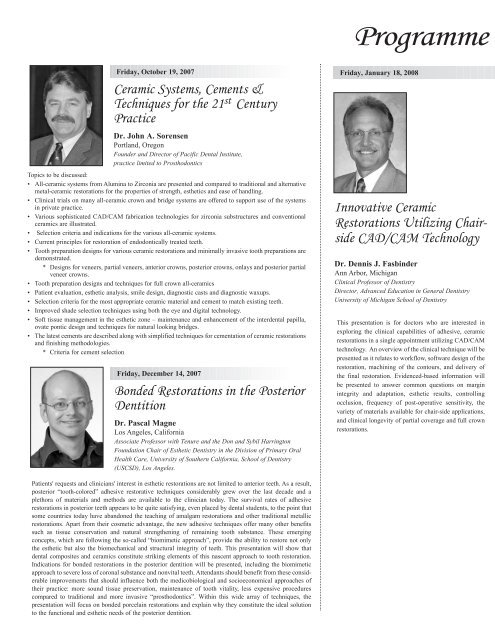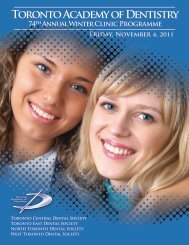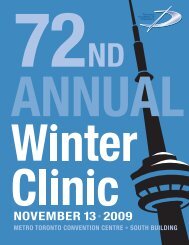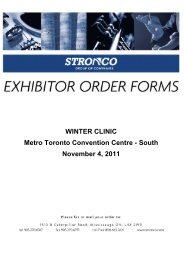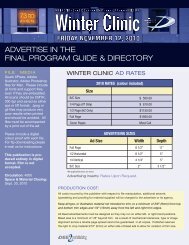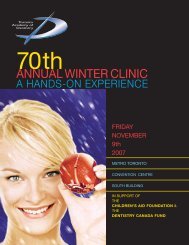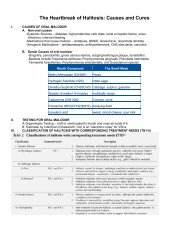meetings will be held at La Primavera - Toronto Academy of Dentistry
meetings will be held at La Primavera - Toronto Academy of Dentistry
meetings will be held at La Primavera - Toronto Academy of Dentistry
Create successful ePaper yourself
Turn your PDF publications into a flip-book with our unique Google optimized e-Paper software.
Programme<br />
Friday, Octo<strong>be</strong>r 19, 2007<br />
Ceramic Systems, Cements &<br />
Techniques for the 21 st Century<br />
Practice<br />
Dr. John A. Sorensen<br />
Portland, Oregon<br />
Founder and Director <strong>of</strong> Pacific Dental Institute,<br />
practice limited to Prosthodontics<br />
Topics to <strong>be</strong> discussed:<br />
• All-ceramic systems from Alumina to Zirconia are presented and compared to traditional and altern<strong>at</strong>ive<br />
metal-ceramic restor<strong>at</strong>ions for the properties <strong>of</strong> strength, esthetics and ease <strong>of</strong> handling.<br />
• Clinical trials on many all-ceramic crown and bridge systems are <strong>of</strong>fered to support use <strong>of</strong> the systems<br />
in priv<strong>at</strong>e practice.<br />
• Various sophistic<strong>at</strong>ed CAD/CAM fabric<strong>at</strong>ion technologies for zirconia substructures and conventional<br />
ceramics are illustr<strong>at</strong>ed.<br />
• Selection criteria and indic<strong>at</strong>ions for the various all-ceramic systems.<br />
• Current principles for restor<strong>at</strong>ion <strong>of</strong> endodontically tre<strong>at</strong>ed teeth.<br />
• Tooth prepar<strong>at</strong>ion designs for various ceramic restor<strong>at</strong>ions and minimally invasive tooth prepar<strong>at</strong>ions are<br />
demonstr<strong>at</strong>ed.<br />
* Designs for veneers, partial veneers, anterior crowns, posterior crowns, onlays and posterior partial<br />
veneer crowns.<br />
• Tooth prepar<strong>at</strong>ion designs and techniques for full crown all-ceramics<br />
• P<strong>at</strong>ient evalu<strong>at</strong>ion, esthetic analysis, smile design, diagnostic casts and diagnostic waxups.<br />
• Selection criteria for the most appropri<strong>at</strong>e ceramic m<strong>at</strong>erial and cement to m<strong>at</strong>ch existing teeth.<br />
• Improved shade selection techniques using both the eye and digital technology.<br />
• S<strong>of</strong>t tissue management in the esthetic zone – maintenance and enhancement <strong>of</strong> the interdental papilla,<br />
ov<strong>at</strong>e pontic design and techniques for n<strong>at</strong>ural looking bridges.<br />
• The l<strong>at</strong>est cements are descri<strong>be</strong>d along with simplified techniques for cement<strong>at</strong>ion <strong>of</strong> ceramic restor<strong>at</strong>ions<br />
and finishing methodologies.<br />
* Criteria for cement selection<br />
Friday, Decem<strong>be</strong>r 14, 2007<br />
Bonded Restor<strong>at</strong>ions in the Posterior<br />
Dentition<br />
Dr. Pascal Magne<br />
Los Angeles, California<br />
Associ<strong>at</strong>e Pr<strong>of</strong>essor with Tenure and the Don and Sybil Harrington<br />
Found<strong>at</strong>ion Chair <strong>of</strong> Esthetic <strong>Dentistry</strong> in the Division <strong>of</strong> Primary Oral<br />
Health Care, University <strong>of</strong> Southern California, School <strong>of</strong> <strong>Dentistry</strong><br />
(USCSD), Los Angeles.<br />
Friday, January 18, 2008<br />
Innov<strong>at</strong>ive Ceramic<br />
Restor<strong>at</strong>ions Utilizing Chairside<br />
CAD/CAM Technology<br />
Dr. Dennis J. Fasbinder<br />
Ann Arbor, Michigan<br />
Clinical Pr<strong>of</strong>essor <strong>of</strong> <strong>Dentistry</strong><br />
Director, Advanced Educ<strong>at</strong>ion in General <strong>Dentistry</strong><br />
University <strong>of</strong> Michigan School <strong>of</strong> <strong>Dentistry</strong><br />
This present<strong>at</strong>ion is for doctors who are interested in<br />
exploring the clinical capabilities <strong>of</strong> adhesive, ceramic<br />
restor<strong>at</strong>ions in a single appointment utilizing CAD/CAM<br />
technology. An overview <strong>of</strong> the clinical technique <strong>will</strong> <strong>be</strong><br />
presented as it rel<strong>at</strong>es to workflow, s<strong>of</strong>tware design <strong>of</strong> the<br />
restor<strong>at</strong>ion, machining <strong>of</strong> the contours, and delivery <strong>of</strong><br />
the final restor<strong>at</strong>ion. Evidenced-based inform<strong>at</strong>ion <strong>will</strong><br />
<strong>be</strong> presented to answer common questions on margin<br />
integrity and adapt<strong>at</strong>ion, esthetic results, controlling<br />
occlusion, frequency <strong>of</strong> post-oper<strong>at</strong>ive sensitivity, the<br />
variety <strong>of</strong> m<strong>at</strong>erials available for chair-side applic<strong>at</strong>ions,<br />
and clinical longevity <strong>of</strong> partial coverage and full crown<br />
restor<strong>at</strong>ions.<br />
P<strong>at</strong>ients' requests and clinicians' interest in esthetic restor<strong>at</strong>ions are not limited to anterior teeth. As a result,<br />
posterior “tooth-colored” adhesive restor<strong>at</strong>ive techniques considerably grew over the last decade and a<br />
plethora <strong>of</strong> m<strong>at</strong>erials and methods are available to the clinician today. The survival r<strong>at</strong>es <strong>of</strong> adhesive<br />
restor<strong>at</strong>ions in posterior teeth appears to <strong>be</strong> quite s<strong>at</strong>isfying, even placed by dental students, to the point th<strong>at</strong><br />
some countries today have abandoned the teaching <strong>of</strong> amalgam restor<strong>at</strong>ions and other traditional metallic<br />
restor<strong>at</strong>ions. Apart from their cosmetic advantage, the new adhesive techniques <strong>of</strong>fer many other <strong>be</strong>nefits<br />
such as tissue conserv<strong>at</strong>ion and n<strong>at</strong>ural strengthening <strong>of</strong> remaining tooth substance. These emerging<br />
concepts, which are following the so-called “biomimetic approach”, provide the ability to restore not only<br />
the esthetic but also the biomechanical and structural integrity <strong>of</strong> teeth. This present<strong>at</strong>ion <strong>will</strong> show th<strong>at</strong><br />
dental composites and ceramics constitute striking elements <strong>of</strong> this nascent approach to tooth restor<strong>at</strong>ion.<br />
Indic<strong>at</strong>ions for bonded restor<strong>at</strong>ions in the posterior dentition <strong>will</strong> <strong>be</strong> presented, including the biomimetic<br />
approach to severe loss <strong>of</strong> coronal substance and nonvital teeth. Attendants should <strong>be</strong>nefit from these considerable<br />
improvements th<strong>at</strong> should influence both the medicobiological and socioeconomical approaches <strong>of</strong><br />
their practice: more sound tissue preserv<strong>at</strong>ion, maintenance <strong>of</strong> tooth vitality, less expensive procedures<br />
compared to traditional and more invasive “prosthodontics”. Within this wide array <strong>of</strong> techniques, the<br />
present<strong>at</strong>ion <strong>will</strong> focus on bonded porcelain restor<strong>at</strong>ions and explain why they constitute the ideal solution<br />
to the functional and esthetic needs <strong>of</strong> the posterior dentition.


